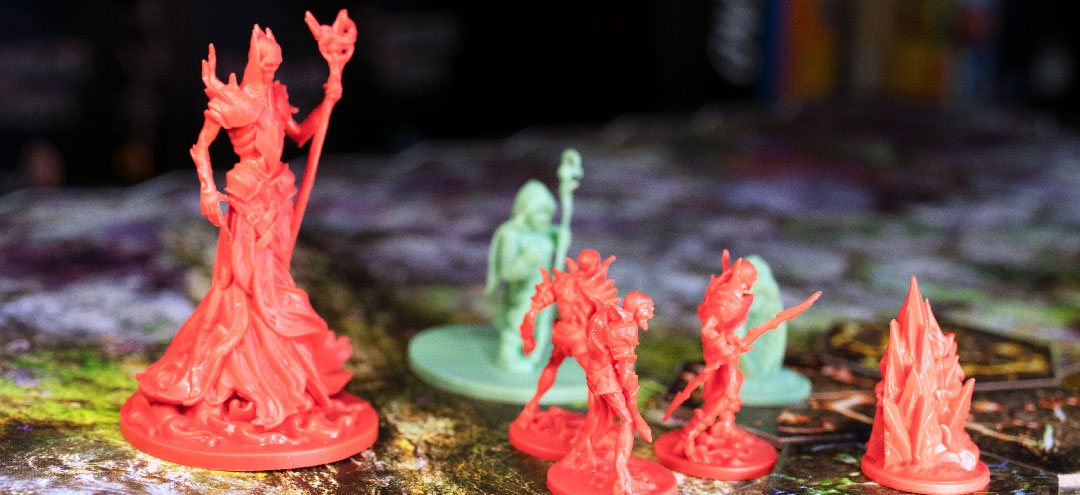 Tear is a funny word. It can mean to rip something apart, but it’s also a noun for the liquid that comes out of your eyes. When I first saw the box cover for Godtear, I immediately thought it was the first definition. I was like cool, a game about a world ripped apart by gods. Sign me up. Flipping through the story in the game, I realized that it’s actually the other definition. In Godtear, players are battling over the tears of former, deceased gods. Well ok then. Assemble your champions, take the field, and claim immortality.
Tear is a funny word. It can mean to rip something apart, but it’s also a noun for the liquid that comes out of your eyes. When I first saw the box cover for Godtear, I immediately thought it was the first definition. I was like cool, a game about a world ripped apart by gods. Sign me up. Flipping through the story in the game, I realized that it’s actually the other definition. In Godtear, players are battling over the tears of former, deceased gods. Well ok then. Assemble your champions, take the field, and claim immortality.
Godtear is a light skirmish game published by Steamforged Games. It plays mainly with two players and the core game takes around 60 minutes to play.
Gameplay Overview:
The core box of Godtear comes with two warbands, a board, custom dice, and some other random bits. The main thing to know about each warband is that they consist of a champion and a handful of followers. Each warband is also divided into one of four categories, which determines what they are good at: killing champions, killing followers, being a defender, or shaping the battlefield.
With only two warbands, the core set of Godtear will be mostly a learning game. To get the full experience, you’ll want to buy at least 4 other warbands as a game of Godtear is best with 3 champions on each side (more on that later).
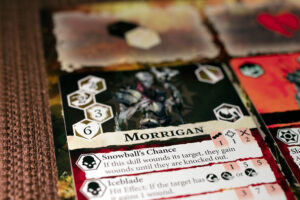
A game of Godtear is divided into five rounds, with each round having two main phases. During the Plot phase, one side will take two actions with all of their units, and then the other side will do the same. Actions might be: moving units, claiming objectives, recruiting followers back, and using character skills. Typically during the Plot phase, no damage is dealt. It’s more about claiming an objective with your banner and positioning for the Clash phase.
During the Clash phase, players will flip their character’s ability cards over to the other side. The actions are mostly the same during the clash phase except skills will be more combat-oriented. Unlike in the Plot phase, the clash phase has players alternating taking actions.
Combat is handled via die rolls and each attacker will roll a number of dice based on their skills Dice have 3 hits, 1 double hit, and 2 blanks. If the roll hits the target’s dodge value, then the attacker will make a damage roll. The same dice are used, but the number of dice rolled will depend on the damage value of the skill used. Any hits rolled are subtracted from the target’s Protection value. Any leftover hits are applied as wounds.
Killing a champion or follower will grant points to move the battle ladder token towards your side. Planting your banner on an objective hex, and also keeping it there till the end of the round will also earn you points. At the end of the round, whichever player has the ladder token on their side gains the VPs for the round. The number of VPs earned each rounds goes from 1,2,3,2, and back to 1 in the 5th round. The first player to 5vps, wins.
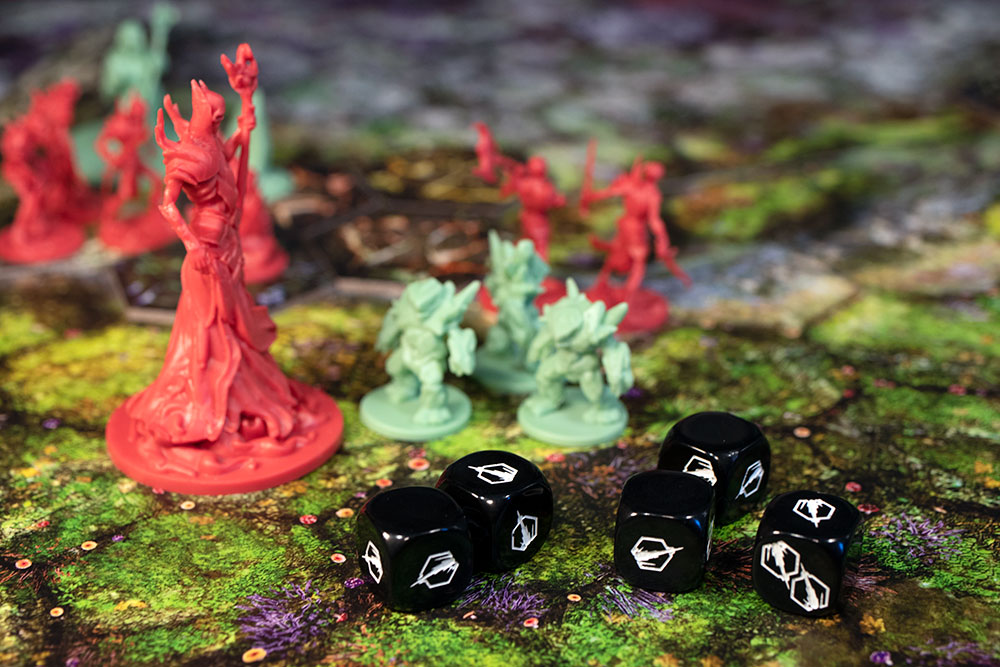
Game Experience:
When we first played Godtear, we each chose 1 warband and went at it. I had a guardian and my opponent had a slayer. It was a nice way to learn the rules, but my warband got a butt-kicking on the battlefield. I just couldn’t keep up with the damage my opponent was putting out. Overall we thought the gameplay was unique and clever, but somewhat lackluster. Eventually, flipping through the rulebook, I realized that 1v1 isn’t the main way to play. The recommended way is with three champions on each side, and after playing the learning game, I whole heartily agree. Having a guardian warband, who spends skill aiding other champions and followers was at a bit of a disadvantage playing by himself. Once we got a variety of units on the battlefield though, the game really started to shine.
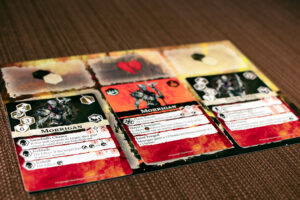
I found the two phase system of Godtear to be a fresh way to handle a skirmish game. The Plot phase is all about setting yourself up and positing yourself for the Clash phase. Even though there are no tape measures or light of sight to worry about, positioning is really important in Godtear. Not just because many units are melee or have limited range, but you really want to get your banner on the objective hexes (and keep them there). Claiming one of those provides as many points as KOing a champion. This allows less combat-oriented champions a way to still shine.
The Clash phase is definitely the most familiar part of the game for any veteran of Skirmish games. Battles will be frequent and with a lot of carnage. However, I have to say, I’m not a huge fan of the dice system. While I’m absolutely not one of those people that hate dice or randomness in games, I felt like the dice in Godtear were just too swingy. Too many times I had a perfect setup and was using a great ability, only to get hosed by rolling too many blanks. If you are rolling 6 dice, your damage can be anywhere from 0 to 12 points and there were times I hit that zero result. The randomness is also increased by the two-roll system. I have to roll these dice to see if I hit, and then roll again to see how much damage I do. The excitement of hitting your opponent can definitely be stamped out by not doing any damage.
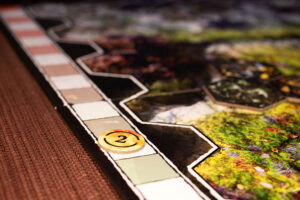
But balancing out this subpar attack system is the excellent ladder mechanic. Godtear is not a game of killing things and gaining points until you hit the magic number. The points each round are isolated from previous rounds. This ties in nicely with the game’s catchup mechanic. The first two rounds combined are worth as many VPs as the third. So even if your opponent jumps out to an early lead and loses the first two rounds, winning round three can bring the game back to a tie. So even if you are getting stomped in the round, you can just forgo trying to win the round, and instead, spend your time trying to setup success for the next. One round I was doing so bad that rather than try and win the round I spent time positioning my champions to easily claim future objectives and also weakening my opponent’s champions to allow for an easy kill in the following round.
Finally, I want to say that I really liked the streamlined gameplay of Godtear. For the most part, there aren’t a ton of rules overhead. You have a champion, their followers, and a handful of skills to learn. I will say though that the rulebook could definitely use some TLC. More than a few times we were confused learning the game and had to hop online to figure out how something worked. That being said, once you get a full learning game under your belt, you can get a game to the table quickly as setup and tear down is almost non-existent.
Final Thoughts:

Godtear has somewhat flown under the radar for me, but we enjoyed our plays of it. What’s nice is that each warband is not only self contained, but color-coded for what it does. Want to pick up a new warband that’s good and stomping on your opponent’s followers? Buy a yellow one. This makes adding to your collection easy as you can just fill the holes you have or expand on your favorite classes. And when you are ready to start a game, you don’t have to pour over tiny cards to outfit each unit with powers and weapons. Grab a warband and their three cards and you are ready to go.
That being said, the 1v1 game in Godtear is OK at best, needed at least 6 total champions to really shine. So the core game is really only a learning box, as you’ll need to have at least four more factions for the full game (and the storage requirements that comes with them). But the minis look excellent, and the gameplay feels not only fresh but streamlined (once you wrap your head around how to play). While I wish the combat system was less swingy, it didn’t stop us from enjoying the game overall.
Final Score: 4 Stars – A great, light skirmish game with some clever and unique mechanics, that’s fairly easy to get to the table.
 Hits:
Hits:
• Quick to get to the table
• Good amount of variety in the factions
• Ladder system is a great idea
• Enjoyed the two-phase mechanic
Misses:
• Attacking is way too swingy
• Rulebook could use some help
• Core game is only a partial experience








